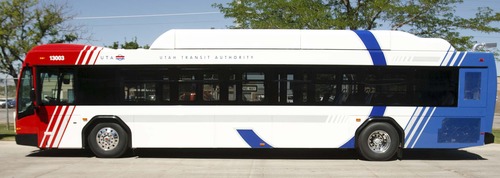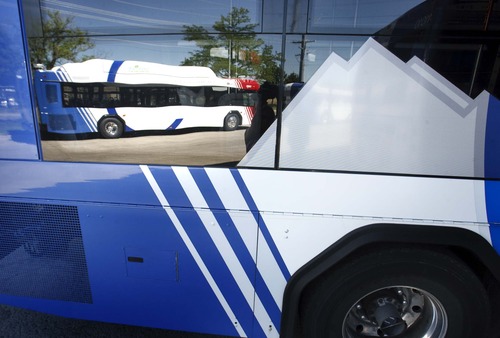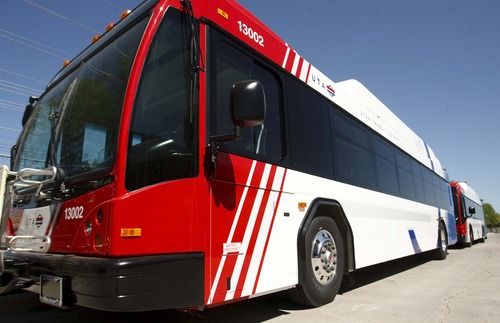This is an archived article that was published on sltrib.com in 2013, and information in the article may be outdated. It is provided only for personal research purposes and may not be reprinted.
The Utah Transit Authority is hopping on the bus of a growing national movement to power transit vehicles with compressed natural gas (CNG) — which is cheaper and cleaner than diesel, although CNG-fueled buses cost more to buy.
UTA just took delivery of its first 10 CNG buses and is painting and preparing them — and training drivers and mechanics on their features. The buses may be seen on the streets shortly in test runs, but are not expected to carry passengers until Aug. 18, the next schedule-change day.
"We're doing it for clean air. We're doing it for energy independence [using Utah natural gas instead of diesel from imported oil]. We're doing it for economics," said UTA General Manager Michael Allegra.
He said the buses should save money in the long run — despite higher initial purchase costs.
"We pay close to $400,000 for a [diesel] bus now, and a CNG bus costs us $450,000 in round numbers," Allegra said. But he says CNG costs about 30 percent less to produce the same mileage, considering all costs needed in conversion.
"The return on investment is only a few years," he said. Allegra adds he hopes to apply long-term savings to offer more service.
Allegra said CNG also is a bit cleaner than diesel — although he says modern clean diesel technology puts it "in the same ballpark" as CNG.
"If I took a snapshot today, CNG is good. CNG is better in some categories than clean diesel," he said. "But I see the technology improving in CNG."
UTA, which has 630 diesel buses, plans to have 24 CNG buses by the end of the year. Allegra said he hopes that UTA will have about 200 CNG buses in three to five years, or roughly a third of its fleet.
"We may go more. It's hard to predict right now," he said. "Frankly the only limiting factor is facilities necessary to fuel them."
UTA plans to make its garage at 600 West on 200 South in downtown Salt Lake City the center for its CNG buses. Allegra said it will eventually have a fueling site there. The building also will make some needed alterations for the new buses — such as moving exhaust fans from the floor to the ceiling because exhaust from CNG rises, while diesel fumes sink.
This is actually the second time that UTA has experimented with CNG buses. It purchased a few in the mid-1990s and retired them in the early 2000s.
"We were among the first in the nation to try them," Allegra said. "We didn't like them. They didn't have the right stuff for our altitude, for our hills." But he said technology has improved vastly since then.
"We've had them out here to kick the tires. We've put them through the paces. They meet our criteria now for altitude and steep grades and energy efficiency," he said.
Allegra adds that when UTA first tried CNG, "there wasn't much interest [nationally]. The pendulum has swung now to a lot of transit agencies investing in CNG buses." He said that interest leads to continual improvements in CNG technology.
About 19 percent of public transit buses now use CNG or liquefied natural gas, according to the American Public Transportation Association.
It said LA Metro in Los Angeles has the nation's largest CNG fleet with 2,200 buses. DART in Dallas is in the process of using CNG to replace all its diesel and other buses by 2015. The Centre Area Transportation Authority in State College, Pa., runs its entire fleet on CNG.







